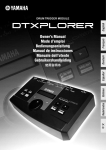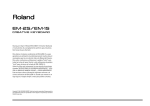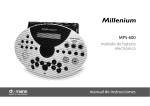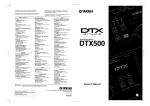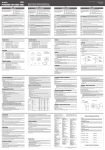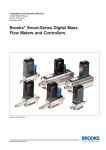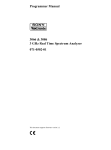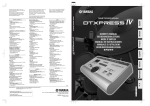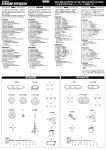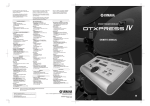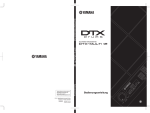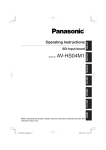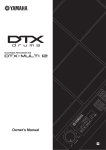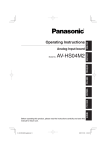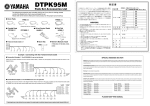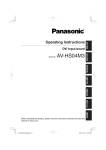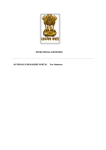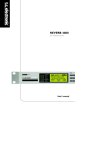Download Owner`s Manual
Transcript
DRUM TRIGGER MODULE Owner’s Manual SPECIAL MESSAGE SECTION This product utilizes batteries or an external power supply (adapter). DO NOT connect this product to any power supply or adapter other than one described in the manual, on the name plate, or specifically recommended by Yamaha. Battery Notice: This product MAY contain a small non-rechargeable battery which (if applicable) is soldered in place. The average life span of this type of battery is approximately five years. When replacement becomes necessary, contact a qualified service representative to perform the replacement. WARNING: Do not place this product in a position where anyone could walk on, trip over ,or roll anything over power or connecting cords of any kind. The use of an extension cord is not recommended! If you must use an extension cord, the minimum wire size for a 25' cord (or less ) is 18 AWG. NOTE: The smaller the AWG number ,the larger the current handling capacity. For longer extension cords, consult a local electrician. This product may also use “household” type batteries. Some of these may be rechargeable. Make sure that the battery being charged is a rechargeable type and that the charger is intended for the battery being charged. This product should be used only with the components supplied or; a cart, rack, or stand that is recommended by Yamaha. If a cart, etc., is used, please observe all safety markings and instructions that accompany the accessory product. When installing batteries, do not mix batteries with new, or with batteries of a different type. Batteries MUST be installed correctly. Mismatches or incorrect installation may result in overheating and battery case rupture. SPECIFICATIONS SUBJECT TO CHANGE: Warning: Do not attempt to disassemble, or incinerate any battery. Keep all batteries away from children. Dispose of used batteries promptly and as regulated by the laws in your area. Note: Check with any retailer of household type batteries in your area for battery disposal information. The information contained in this manual is believed to be correct at the time of printing. However, Yamaha reserves the right to change or modify any of the specifications without notice or obligation to update existing units. Disposal Notice: This product, either alone or in combination with an amplifier and headphones or speaker/ s, may be capable of producing sound levels that could cause permanent hearing loss. DO NOT operate for long periods of time at a high volume level or at a level that is uncomfortable. If you experience any hearing loss or ringing in the ears, you should consult an audiologist. IMPORTANT: The louder the sound, the shorter the time period before damage occurs. Should this product become damaged beyond repair, or for some reason its useful life is considered to be at an end, please observe all local, state, and federal regulations that relate to the disposal of products that contain lead, batteries, plastics, etc. If your dealer is unable to assist you, please contact Yamaha directly. NAME PLATE LOCATION: Some Yamaha products may have benches and / or accessory mounting fixtures that are either supplied with the product or as optional accessories. Some of these items are designed to be dealer assembled or installed. Please make sure that benches are stable and any optional fixtures (where applicable) are well secured BEFORE using. The name plate is located on the bottom of the product. The name plate lists the product’s model number, power requirements, and other information. The serial number is located on the rear panel. Please record the model number, serial number, and date of purchase in the spaces provided below, and keep this manual as a permanent record of your purchase. NOTICE: Service charges incurred due to a lack of knowledge relating to how a function or effect works (when the unit is operating as designed) are not covered by the manufacturer’s warranty, and are therefore the owners responsibility. Please study this manual carefully and consult your dealer before requesting service. Model ENVIRONMENTAL ISSUES: Serial No. Yamaha strives to produce products that are both user safe and environmentally friendly. We sincerely believe that our products and the production methods used to produce them, meet these goals. In keeping with both the letter and the spirit of the law, we want you to be aware of the following: 92-BP (others) Purchase Date PLEASE KEEP THIS MANUAL FCC INFORMATION (U.S.A.) tee that interference will not occur in all installations. If this product is found to be the source of interference, which can be determined by turning the unit “OFF” and “ON”, please try to eliminate the problem by using one of the following measures: Relocate either this product or the device that is being affected by the interference. Utilize power outlets that are on different branch (circuit breaker or fuse) circuits or install AC line filter/s. In the case of radio or TV interference, relocate/reorient the antenna. If the antenna lead-in is 300 ohm ribbon lead, change the lead-in to co-axial type cable. If these corrective measures do not produce satisfactory results, please contact the local retailer authorized to distribute this type of product. If you can not locate the appropriate retailer, please contact Yamaha Corporation of America, Electronic Service Division, 6600 Orangethorpe Ave, Buena Park, CA90620 The above statements apply ONLY to those products distributed by Yamaha Corporation of America or its subsidiaries. 1. IMPORTANT NOTICE: DO NOT MODIFY THIS UNIT! This product, when installed as indicated in the instructions contained in this manual, meets FCC requirements. Modifications not expressly approved by Yamaha may void your authority, granted by the FCC, to use the product. 2. IMPORTANT : When connecting this product to accessories and/or another product use only high quality shielded cables. Cable/s supplied with this product MUST be used. Follow all installation instructions. Failure to follow instructions could void your FCC authorization to use this product in the USA. 3. NOTE : This product has been tested and found to comply with the requirements listed in FCC Regulations, Part 15 for Class “B” digital devices. Compliance with these requirements provides a reasonable level of assurance that your use of this product in a residential environment will not result in harmful interference with other electronic devices. This equipment generates/uses radio frequencies and, if not installed and used according to the instructions found in the users manual, may cause interference harmful to the operation of other electronic devices. Compliance with FCC regulations does not guaran* This applies only to products distributed by YAMAHA CORPORATION OF AMERICA. NEDERLAND / THE NETHERLANDS • Dit apparaat bevat een lithium batterij voor geheugen back-up. • This apparatus contains a lithium battery for memory back-up. • Raadpleeg uw leverancier over de verwijdering van de batterij op het moment dat u het apparaat ann het einde van de levensduur afdankt of de volgende Yamaha Service AfdeIIng: Yamaha Music Nederland Service AfdeIIng Kanaalweg 18-G, 3526 KL UTRECHT Tel. 030-2828425 • For the removal of the battery at the moment of the disposal at the end of the service life please consult your retailer or Yamaha Service Center as follows: Yamaha Music Nederland Service Center Address : Kanaalweg 18-G, 3526 KL UTRECHT Tel : 030-2828425 • Gooi de batterij niet weg, maar lever hem in als KCA. • Do not throw away the battery. Instead, hand it in as small chemical waste. 2 DTXPLORER_E_R2 (lithium disposal) Page 2 (class B) ADVARSEL! Lithiumbatteri—Eksplosionsfare ved fejlagtig håndtering. Udskiftning må kun ske med batteri af samme fabrikat og type. Levér det brugte batteri tilbage til leverandoren. VARNING Explosionsfara vid felaktigt batteribyte. Använd samma batterityp eller en ekvivalent typ som rekommenderas av apparattillverkaren. Kassera använt batteri enlight fabrikantens instruktion. VAROITUS Paristo voi räjähtää, jos se on virheellisesti asennettu. Vaihda paristo ainoastaan laitevalmistajan suosittelemaan tyyppiin. Hävitä käytetty paristo valmistajan ohjeiden mukaisesti. (lithium caution) Caution Use ONLY a Yamaha PA-3C AC Power Adaptor (or other adaptor specifically recommended by Yamaha) to power your instrument from the AC mains. The use of other adaptors may result in irreparable damage to both the adaptor and the instrument. 05.11.16, 3:25 PM Adobe PageMaker 6.0J/PPC PRECAUTIONS PLEASE READ CAREFULLY BEFORE PROCEEDING * Please keep this manual in a safe place for future reference. WARNING Always follow the basic precautions listed below to avoid the possibility of serious injury or even death from electrical shock, short-circuiting, damages, fire or other hazards. These precautions include, but are not limited to, the following: Power supply/AC power adaptor • Only use the voltage specified as correct for the instrument. The required voltage is printed on the name plate of the instrument. • Use the specified adaptor (PA-3C or an equivalent recommended by Yamaha) only. Using the wrong adaptor can result in damage to the instrument or overheating. • Check the electric plug periodically and remove any dirt or dust which may have accumulated on it. • Do not place the AC adaptor cord near heat sources such as heaters or radiators, and do not excessively bend or otherwise damage the cord, place heavy objects on it, or place it in a position where anyone could walk on, trip over, or roll anything over it. Do not open • Do not open the instrument or attempt to disassemble the internal parts or modify them in any way. The instrument contains no user-serviceable parts. If it should appear to be malfunctioning, discontinue use immediately and have it inspected by qualified Yamaha service personnel. Water warning • Do not expose the instrument to rain, use it near water or in damp or wet conditions, or place containers on it containing liquids which might spill into any openings. • Never insert or remove an electric plug with wet hands. Fire warning • Do not put burning items, such as candles, on the unit. A burning item may fall over and cause a fire. If you notice any abnormality • If the AC adaptor cord or plug becomes frayed or damaged, or if there is a sudden loss of sound during use of the instrument, or if any unusual smells or smoke should appear to be caused by it, immediately turn off the power switch, disconnect the adaptor plug from the outlet, and have the instrument inspected by qualified Yamaha service personnel. CAUTION Always follow the basic precautions listed below to avoid the possibility of physical injury to you or others, or damage to the instrument or other property. These precautions include, but are not limited to, the following: Power supply/AC power adaptor • When removing the electric plug from the instrument or an outlet, always hold the plug itself and not the cord. • Unplug the AC power adaptor when not using the instrument, or during electrical storms. • Do not connect the instrument to an electrical outlet using a multiple-connector. Doing so can result in lower sound quality, or possibly cause overheating in the outlet. Location • Do not expose the instrument to excessive dust or vibrations, or extreme cold or heat (such as in direct sunlight, near a heater, or in a car during the day) to prevent the possibility of panel disfiguration or damage to the internal components. • Do not use the instrument in the vicinity of a TV, radio, stereo equipment, mobile phone, or other electric devices. Otherwise, the instrument, TV, or radio may generate noise. • Do not place the instrument in an unstable position where it might accidentally fall over. • Before moving the instrument, remove all connected adaptor and other cables. • Use only the stand/rack specified for the instrument. When attaching the stand or rack, use the provided screws only. Failure to do so could cause damage to the internal components or result in the instrument falling over. Connections • Before connecting the instrument to other electronic components, turn off the power for all components. Before turning the power on or off for all components, set all volume levels to minimum. Also, be sure to set the volumes of all components at their minimum levels and gradually raise the volume controls while playing the instrument to set the desired listening level. Maintenance • When cleaning the instrument, use a soft, dry cloth. Do not use paint thinners, solvents, cleaning fluids, or chemical-impregnated wiping cloths. Handling caution • Do not place vinyl, plastic or rubber objects on the instrument, since this might discolor the panel or keyboard. • Do not rest your weight on, or place heavy objects on the instrument, and do not use excessive force on the buttons, switches or connectors. • Do not operate the instrument for a long period of time at a high or uncomfortable volume level, since this can cause permanent hearing loss. If you experience any hearing loss or ringing in the ears, consult a physician. Backup battery • This instrument has a built-in lithium backup battery. When you unplug the power cord from the AC outlet, the internal data is retained. However, if the backup battery fully discharges, this data will be lost. When the backup battery is running low, the display indicates “Battery Low.” In this case, immediately memo the data settings, then have qualified Yamaha service personnel replace the backup battery. Yamaha cannot be held responsible for damage caused by improper use or modifications to the instrument, or data that is lost or destroyed. Always turn the power off when the instrument is not in use. Even when the power switch is in the “STANDBY” position, electricity is still flowing to the instrument at the minimum level. When you are not using the instrument for a long time, make sure you unplug the AC power adaptor from the wall AC outlet. Make sure to discard used batteries according to local regulations. (3)-7 3 Thank you for purchasing the Yamaha DTXPLORER. The DTXPLORER is a compact drum trigger module that includes a wealth of rich, high-quality drum voices, a multi-function metronome, and song play function. To get the most out of the DTXPLORER, please read this manual thoroughly. After reading the manual, keep it in a safe place for future reference. About the descriptions This manual describes buttons and explanations using the following rules. • • • • • [DRUM KIT], [CLICK], etc. [SHIFT]+[DRUM KIT], etc. [<]/[>], etc. “Completed!”, etc. m P. 12, etc. The button on the top panel is indicated with [ ]. (brackets). Means hold the [SHIFT] button and press the [DRUM KIT] button. Means use the [<] button or [>] button. Words inside “ ” indicate the message shown on the display. Indicates the reference page where further information can be found. NOTE The illustrations and LCD screens as shown in this owner’s manual are for instructional purposes only, and may appear somewhat different from those on your instrument. Inside this package This package contains the following items. After opening the package, please check and makes sure that all the items In the list are present. • The DTXPLORER • Power Adaptor * • Owner’s Manual (this book) * May not be included depending on your particular area. Please check with your Yamaha dealer. 4 DTXPLORER_E_R2 Page 4 05.11.17, 4:37 PM Adobe PageMaker 6.0J/PPC The DTXPLORER’s Main FeaturesMain Features The DTXPLORER is equipped with a high-quality 32-polyphony tone generator that produces realistic voices, a high-performance metronome, and a variety of songs, all built into a compact design. The DTXPLORER is a versatile instrument that can be used in a variety of situations such as live performance, personal practice, and much more. ■ Drum Trigger Function • Built into the unit are nine trigger input jacks and a hi-hat controller jack. Jacks that are compatible with rim switch and 3-zone trigger equipped pads are also supplied. In addition to trigger pad compatibility, the unit can also be used with devices such as Yamaha’s DT20 Drum Triggers, etc. • Setup data such as pad trigger input type, sensitivity settings, etc., are stored in four preset patterns. This lets you simply choose the system that meets your playing needs. The unit also provides a pattern for user memory in which you can create and store your own custom settings for pads or drum triggers. • Also included in the unit are 32 preset drum kits. Acoustic drum kit types cover a range of genres from rock, funk, jazz, reggae, Latin percussion, etc. and are readily available for use. There are also 10 user memory kits in which you can freely mix, match and edit a variety of drum/percussion voices to create your own original drum kits. ■ Tone Generator • The DTXPLORER is equipped with a high-quality, 16-bit AWM2 (PCM) tone generator with 32 voice polyphony. • Voices include 192 drum and percussion voices. Voices cover a wide range of sounds such as highly realistic acoustic sounds, unique electronic percussion sounds, effect sounds, and much more. • Also featured is the same internal digital reverb section that is found in Yamaha’s MU series of GM/XG compatible tone generators. ■ High Performance Metronome • The sound for each note value is adjustable. Each note value can be assigned its own separate click voice and pitch. You can also set a timer that will determine when the metronome stops and set breaks which how many measures the metronome will play and then be muted. • The DTXPLORER also features a “Tap” function that lets you set the tempo for the metronome or song by tapping in tempo on a pad to any tempo you like. ■ Preset Songs • The sequencer contains 22 preset songs (two demo songs plus 20 pattern songs). Two functions that make the DTXPLORER great for practice are the Bass Solo Function—which lets you play along with the song’s bass part only—and the Drum Mute Function—which mutes a specific drum part. ■ Groove Check Function • The Groove Check Function is a great training aid that will let you know how accurate your playing is and check your consistency in dynamics (output level). This function is an excellent aid for those who want to increase their precision in playing. ■ Interface • A MIDI OUT jack on the rear panel lets you play sounds from an external tone generator or synchronize the metronome with an external sequencer. • An AUX IN (Auxiliary In) jack lets you plug in an external audio device such as a CD player, MD player, etc., and play along. • A headphones jack is also included. 5 CONTENTS Nomenclature .......................................................................... 7 Top Panel ..................................................................................... 7 Rear Panel ................................................................................... 8 Connections ............................................................................ 9 Connecting the DTXPLORER’s pads to the main unit ................. 9 Using the DTXPLORER with an Acoustic Drum Kit .................... 9 ■ Connecting External Devices ................................................. 10 ■ Connecting the Power Supply ................................................ 11 Time to Play ........................................................................... 12 Adjusting the Hi-Hat ................................................................... 13 Play Along With The Metronome .......................................... 14 Click Out Select ......................................................................... 16 Play Along With a Song! ....................................................... 17 Tap Tempo Function................................................................... 18 Using the Groove Check Function ...................................... 19 Create Your Own Original Drum Kit ..................................... 20 Factory Set ................................................................................ 23 Trigger Setup Edit ................................................................. 24 Selecting the Trigger Setup ........................................................ 24 Editing the Trigger Setup ........................................................... 24 Error Messages ..................................................................... 28 Trouble Shooting ................................................................... 28 Specifications ........................................................................ 30 MIDI Data Format ................................................................... 31 MIDI Transmit Note Number ................................................. 31 Display Global View .............................................................. 32 MIDI Implementation Chart................................................... 34 Drum Voice List ..................................................................... 35 Preset Drum Kit List .............................................................. 35 Preset Song List .................................................................... 35 6 Nomenclature Top Panel DC IN 12V STANDBY VOLUME ON AUX IN PHONES HI HAT CONTROL 8 KICK/9 L/MONO R 7 HI HAT 4 TOM3 6 CRASH 3TOM2 MIDI OUT 5 RIDE 2 TOM1 1 SNARE i q w DRUM KIT CLICK TRIGGER GRV.CHECK * * DTXPLORER Welcome! BEAT o * * e t CLICK SONG / DRUM MUTE DRUM TRIGGER MODULE ON/OFF SHIFT r !0 SAVE/ENT TAP UTILITY y u q Drum Kit Button (DRUM KIT) y Metronome ON/OFF Button ( • This button is used to enter the Drum Kit Select display. (P. 12) • Hold the [SHIFT] button and press the [DRUM KIT] button to enter the Trigger Setup Select display (P. 24) • Stops production of any voices being produced. • This button is used to Start/Stop metronome playback (click sound). (P. 14) • Hold the [SHIFT] button and press the [ ON/OFF] button to enter the Tap Tempo Setting display. (P. 18) w Click Button (CLICK) u Save/Enter Button (SAVE/ENT) • This button is used to enter the Click (Metronome) Setting display. (P. 14) • Hold the [SHIFT] button and press the [CLICK] button to enter the Groove Check Setting display. (P. 19) • This button is used to carry out the command (Enter), or save data. • Hold the [SHIFT] button and press the [SAVE/ENT] button to enter the Utility Mode, which is used to make overall settings for operating the DTXPLORER. • In the Song display, this button is used to start/stop song playback. e Song Button (SONG >/■) • This button is used to enter the Song Select display. (P. 17) • Hold the [SHIFT] button and press the [SONG >/■] button to mute only the drum part during playback. (Drum Mute Function) • Press this button to start/stop song playback. ON/OFF) i LCD Display Shows information or data that is needed to operate the DTXPLORER. r Shift Button (SHIFT) o Click Lamp Hold this button to access the secondary function of another button. The red lamp lights on the first beat of every measure when the metronome or a song is playing. The other beats are indicated with a green light. t Select Buttons (<, >) • These buttons are used to select (the selected item flashes) an item you want to edit. If there are multiple pages, either before or after the page currently displayed, the buttons are used to view the next or previous page. Hold the button to continuously move the flashing cursor. • Hold the [SHIFT] button and press the [<]/[>] buttons to select the select the item you want to edit when a page that allows editing is open. !0 Jog Dial Rotate the jog dial to change the value selected with the flashing cursor (the item being edited) in the display. Rotate the dial to the right (clockwise) to increase the value, and to the left to decrease. Hold the [SHIFT] button and rotate the Jog Dial to increase/decrease the value by 10. 7 Nomenclature Rear Panel !1 !2 !5 !6 !7 !8 ON 1 SNARE 2 TOM1 3TOM2 4 TOM3 R L/MONO PHONES MIN MAX AUX IN VOLUME MIDI OUT 5 RIDE 6 CRASH 7 HI HAT 8 KICK/9 HI HAT CONTROL DC IN 12V !3 !4 !9 !2 STANDBY @0 @1 !1 MIDI OUT Jack !5 Output Jacks (OUTPUT L/MONO, R) This jack is used to send data from the DTXPLORER to an external MIDI device. With this jack, you can use the DTXPLORER as a control device to trigger voices from an external tone generator, or synchronize the DTXPLORER’s song or metronome playback with the playback of an external sequencer. (P. 11) These jacks are used to connect the DTXPLORER to an external amplifier, mixer, etc. For monaural playback use the L/MONO jack. For stereo playback connect both L/R jacks. !2 Trigger Input Jacks (1 SNARE thru 7 HI HAT) These jacks are used to connect the pads or trigger sensors to the main unit. Connect pads such as snare, tom, etc., according to the indication below each input. (P. 9) 3-zone jack .................................... 1 SNARE jack Stereo (w/switch) jacks ................. 5 RIDE, 6 CRASH jacks Monaural jacks .............................. 2 TOM1, 3 TOM2, 4 TOM3, 7 HI HAT jacks !6 Head Phone Jack (PHONES) Connect a pair of headphones to this jack to monitor the DTXPLORER. (P. 10) !7 AUX IN Jack Connect the output of an external audio device, etc., to this jack (stereo mini jack). (P. 10) This is convenient for playing along with music from a CD or cassette player. * Use the volume control on the external device (CD, cassette player, etc.) to adjust the volume balance. !3 Trigger Input jack (8 KICK/9) !8 Master Volume (VOLUME) This jack is used to connect a pad or trigger sensor. Normally, connect kick pad to this jack however, a parallel cable (stereo plug ↔ monaural jack x2, refer to the illustration below) connected to this jack lets you connect two monaural pads to the jack. Also, if the KP65 kick pad is connected to this jack with a stereo cable, the external pad input jack on the KP65 can be used as the input for Input jack 9. Adjusts the DTXPLORER’s overall volume (output level of the signal delivered by the OUTPUT jacks and PHONE jack). Rotate the knob clockwise to increase volume, and counter-clockwise to decrease. !9 Power Supply Jack (DC IN 12V) Connect an AC adaptor to this jack. To prevent the adaptor from becoming unplugged, secure the cord to the cord hook @0. Monaural Phone Jack @0 Cord Hook Stereo Phone Plug Prevents the power cord from accidentally becoming unplugged. (P. 11) Monaural Phone Jack @1 Power Switch (POWER) This is the DTXPLORER’s power switch. !4 Hi-Hat Controller Jack (HI HAT CONTROL) This jack is used to connect a hi-hat controller. (P. 9) * Use a cable with a stereo plug (shown below) when connecting a Hi-hat controller. Double Insulator 8 Connections CAUTION To prevent electric shock and damage to the devices, make sure the power is switched OFF on the DTXPLORER and all related devices before making any connections to the DTXPLORER’s input and output jacks. Connecting the DTXPLORER’s pads to the main unit Refer to the illustration below and connect each pad’s output cable to each Trigger Input jack on the rear panel of the DTXPLORER. All Trigger Input Jacks are labeled (1 SNARE, etc.) so make sure each pad is connected to its corresponding Trigger Input jack. * The DTXPLORER’s settings will provide optimum performance when pads (1 SNARE, etc.) are connected to their corresponding Trigger Input jacks, however, if other pads or drum triggers that have different operating characteristics are connected to the jacks, settings for sensitivity, etc., as described in the “Trigger Setup Edit” section (P. 24) should be changed. to 6 CRASH to 5 RIDE to 7 HI HAT to 3 TOM2 to 2 TOM1 to 1 SNARE to 4 TOM3 to 8 KICK/9 to HI HAT CONTROL Using the DTXPLORER with an Acoustic Drum Kit The DTXPLORER can be played from an acoustic drum kit if the kit is fitted with an optional set of Yamaha DX20 Drum Triggers and the triggers are connected to the DTXPLORER’s input jacks. * After making connections, make sure settings in the DTXPLORER’s trigger setup (P. 24) are properly adjusted. 9 Connections ■ Connecting External Devices ● Some Advice On Connections • Trigger Input jacks 5 RIDE and 6 CRASH are stereo input type jacks. These jacks can be connected to switch equipped pads such as the TP65S, PCY65S, PCY130S, etc. • 3-Zone pads like the TP65S, PCY150S, etc., can be connected to Trigger Input jack 1 SNARE. • Pad sensitivity is set in the Trigger Setup Edit’s [TRIG2 Type (Pad type)] setting (P. 25). • The 8 KICK/9 jack accepts a 2-trigger input using a stereo cable and jack for L (8) and R (9) signals. A parallel cable (stereo plug ↔ monaural jack x2) can be used to input two trigger signals. Also, if the KP65 kick pad is connected to the DTXPLORER’s input jack 9 with a stereo cable, the external pad input jack on the KP65 can be used as the input for Input jack 9. CAUTION Whenever making connections, make sure that the cable being used is equipped with a plug that corresponds to the jack type on the specific device. ● OUTPUT L/MONO, R Jack (Monaural Standard Phone Jack) With these jacks you can connect the DTXPLORER to a mixer or audio equipment to produce sound from external speakers, or connect the DTXPLORER to audio recording equipment for recording your own performance. * Use the DTXPLORER’s OUTPUT L/MONO jack when connecting to a device with a monaural input. ● PHONES Jack (Standard Stereo Phone Jack) Use the VOLUME knob on the rear panel to adjust headphone volume. Whenever using headphones, take care not to damage your hearing. Use the equipment with the volume adjusted to a comfortable level. ● AUX IN Jack (Stereo Mini Phone Jack) You can connect the audio outputs from a CD player, or other external audio source, to the AUX IN jack to mix the signal from the external source with the signal from the DTXPLORER. The combined audio can be sent on to an external device via the DTXPLORER’s output jacks. This jack can be used when you want to play along with a favorite tune or perform with friends. * Use the volume control on the external device (CD player, etc.) to adjust the volume balance. 10 Connections ● MIDI OUT Jack ■ Connecting the Power Supply The DTXPLORER’s MIDI function lets you play voices on an external tone generator with the DTXPLORER’s pads, or synchronize the DTXPLORER’s song or metronome playback with the playback of an external sequencer. A special power source adaptor supplies power to the DTXPLORER. About MIDI MIDI (Musical Instrument Digital Interface) is a world standard that provides a means to connect instruments and computers and allow them to transmit and receive performance and other data. This standard allows computers and instruments of different makers and types to communicate. Make sure the power is switched OFF and connect the supplied power adaptor to the DC IN jack on the rear panel. To prevent the cord from becoming unplugged, wrap the cord around the cord hook and secure. Always use a standard MIDI cable when connecting devices. Also, use a MIDI cable that is not more than 15m in length. Using a longer cable may result in irregular operation and other problems. WARNING Make sure that the power adaptor’s cord is not bent at an acute angle when wrapping the cord onto the hook. Such a situation can result in a damaged power cord or fire. WARNING Please use the supplied power adaptor. The use of any other power source may cause irregular operation or damage to the device. Also, when the DTXPLORER is not to be used for a long period of time, please unplug the power adaptor. Before switching the power ON. • To protect the speakers, headphones and the DTXPLORER from damage, fully rotate the POWER/ VOL knob to the left (minimum volume) before switching the power ON. • Make sure the power is switched OFF on all external devices connected to the DTXPLORER. After the DTXPLORER’s power is switched ON, switch the other device’s power ON. 11 Time to Play Now that your DTXPLORER is properly connected, it’s time to make some music! 1. Switch the power ON 3. Select A Drum Kit After confirming that all devices, pads, external devices, etc., are properly connected, press the POWER switch located on the rear panel to switch the power ON. After purchasing the DTXPLORER, the following message will appear in the display the first time you switch the power on. * * DTXPLORER Welcome! * * After hitting a pad several times, switch the power off and then on again, and the total number times the pads have been hit is shown in the display (Hit Counter Function). * The Hit Counter is reset to “0” after carrying out the factory set. (P. 23) * * DTXPLORER 5hits * * When the Drum Kit Select display (shown below) appears, the DTXPLORER is ready to be played. * The most recently used drum kit is selected in the display. * Press the [DRUM KIT] button if another display is shown. Each kit is made up of voices that are produced when a pad is hit. Drum kit numbers 1 through 32 consist of 32 different types of preset drum kits that have been specially programmed by Yamaha sound designers. Rotate the jog dial to select a drum kit. KIT1 _________ 1 :Acoustic ‚ Drum Kit Number Drum Kit Name Try out some of the different drum kits and select a kit you’d like to use. 4. Change the Output Sound Quality Use the [Master Equalizer] display found on page 4 in the Utility Mode to change the output sound quality. Overall settings for the DTXPLORER are set in the Utility Mode. First, press the [SHIFT] + [SAVE/ENT] buttons to enter page 1 in the Utility Mode. Page 1 of the Utility Mode KIT1 _________ 1 :Acoustic ‚ Drum Kit Number UTIL1 Hi-hat HHofs= 0 T= 0‚ Drum Kit Name CAUTION To avoid damage to your speakers, first switch the DTXPLORER’s power ON then switch on Audio Devices and the Mixer or Amplifier. 2. Play the DTXPLORER While hitting on the pads, rotate the volume knob on the rear panel to the right to increase the overall volume to a comfortable volume level. Rotating the knob to the right increases the volume level while rotating to the left decreases. The “HHofs=” value is flashing. Press the [>] button once to move the flashing cursor to the “T=” value position. UTIL1 Hi-hat HHofs= 0 T= 0‚ Press the [>] button again to go to page 2 in the Utility Mode. The “OutSel=” value is flashing. UTIL2 Click –OutSel=mix ‚ Press the [>] button twice to go to page 4 in the Utility Mode. UTIL4 MasterEQ –Lo=+ 4 Hi=+ 8 ‚ 12 Time to Play Use the [<]/[>] buttons in this manner to select (the flashing cursor) the item you want to set. When the page only contains a single item, pressing the [<]/[>] buttons will select the next or previous page. * The “‚” mark on the lower right side of the display indicates that a succeeding page exists. Likewise, the “–” mark on the lower left side of the display indicates a previous page exists. Now use the Master Equalizer (2-band shelving type) setting to change the sound quality. The “Lo=” value is flashing. To increase low frequency emphasis, rotate the jog dial to adjust the value (low frequency gain: +0dB to +12dB). UTIL4 MasterEQ –Lo=+ 4 Hi=+ 8 ‚ Similarly, press the [>] button to flash the “Hi=” value, then rotate the jog dial to adjust the high frequency gain (+0dB to +12dB). You can also adjust or set the individual pad voices, volume, tuning, reverb type/level, and other settings that finetune the DTXPLORER. (P. 20) Adjusting the Hi-Hat Hi-hat adjustment is used to determine the point at which the hi-hat closes when the hi-hat pedal (foot controller) is pressed. You can also set the ease at which foot splashes are produced. * This setting is only valid when a foot controller is connected to the HI HAT CONTROL jack. The setting has no effect on a foot controller connected to any other jack. Procedure 1. Press the [SHIFT] + [SAVE/ENT] buttons to view the following page (page 1 in the Utility Mode). Use this display to adjust the hi-hat. UTIL1 Hi-hat HHofs= 0 T= 0‚ 2. To set the point at which the hi-hat closes, flash the “HHofs=” value then use the jog dial to adjust the value. The setting has a range of –32 to 0 to +32. Smaller values produce a shallower closing point. UTIL1 Hi-hat HHofs=-12 T= 0‚ To set the ease at which foot splashes are produced, flash the “T=” value then use the jog dial to adjust the value. The setting has a range of 0 to 127. Larger values make foot splashes that are long and easier to produce. * Too high a value will makes foot splashes too easy to produce, resulting in the continuous production of foot splashes when the pedal is held down continuously. UTIL1 Hi-hat HHofs=-12 T= 20‚ 13 Play Along With The Metronome Start the metronome and play along on the DTXPLORER’s pads. The DTXPLORER is equipped with a high performance metronome that lets you create complex rhythms. 1. Start the Metronome Press the [ ON/OFF] button to start the metronome. The red lamp lights on the first beat of every measure when the metronome is playing. Other beats are indicated with the green lamp. Press the [ ON/OFF] button again to stop the metronome. Use this display to select the click set and then set the beat, tempo, timer, and the click sound’s overall volume. Press the [<]/[>] buttons to move the flashing cursor to the item you want to set, then rotate the jog dial to set its value. Click setting display page number (page 1) Timer Click Master Volume CLK1 fl ’¬ 1 :Beat=4 ƒ=152‚ Click Set Number Tempo Beat 2. Set the settings for Click Set, Tempo, Beat, etc. By fine tuning the different note value clicks that are shown in the illustration below, the DTXPLORER’s metronome can be used to create a variety of click patterns. The patterns you set are called Click Sets, and you can save up to 30 original patterns in the DTXPLORER’s memory. Example) Beat timings used when Beat=4 • Click Set Number [Range: 1 to 30] Selects the click set to be used. • Beat [Range: 1 to 9] Sets the click’s time signature. • Tempo [Range: 30 to 300] Sets the click’s tempo (q=). The Tap Tempo Function can be used to set the tempo. In this function, hitting the pads in tempo sets the song or click’s tempo. This let’s you set the tempo to any tempo you like. Refer to page 18 for more information. • Timer [Range: off, 30 to 600 seconds] This function is used to automatically stop the metronome at the time set in this setting. • Click Master Volume [Range: 0 to 16] Sets the click’s overall volume. * When the flashing cursor is not positioned here, the speaker icon will be displayed. First, select a click set from one of the presets and listen. Press the [CLICK] button to view page 1 in the Click Setting. CLK1 fl ’¬ 1 :Beat=4 ƒ=152‚ An asterisk “*” will appear next to “CLK1” in the display if the beat or tempo setting is changed. This is to let you know that data has been changed. This mark will disappear after the Store Operation (P. 16) is carried out to save data in the DTXPLORER’s memory. If a different click set is selected before carrying out the Store Operation, the current settings will return to their original condition. If you want to keep changes made to the data, make sure you carry out the Store Operation. CLK1* fl ’¬ 1 :Beat=4 ƒ=152‚ 14 Play Along With The Metronome 3. Create Your Own Original Click Set Click Value Type Press the [>] button to view page 2 in the Click Setting. CLK2 A”=9 «=9 – »=6 ……=4 Œ=2 ‚ CLK5 Sound= « –K/001 Maple 22‚ Voice Category/Voice Number Voice Name Use this display to set the individual volume levels (0 to 9) for each of the five click beats. Set the volume level to “0” if you don’t want the beat to be produced. Use this page to create your own original click set. 4. Set the Click Measure Break Press the [>] button to view the [Click Measure Break] section on page 3 in the Click Setting. You can assign a different drum voice to each of the metronome’s five click voices. * This setting is not available if the setting for CLK4 is set to anything other than “UserClick”. First, select the click value type (A”, «, », ……, Œ) in the upper half of the display, then move the flashing cursor to the lower half of the display and select the voice you want to assign to the click. First, select the voice category. CLK3 MeasBreak –Meas=1 Brk=3 ‚ The Click Measure Break puts a muted “break” for the number of measures decided with the “Brk” setting (off, 1 to 9) after the metronome has played for the number of measures determined by the “Meas” setting (1 to 9). * If the setting “Brk=off” is used, the metronome will not be muted. 5. Set the Click Voice Set Press the [>] button to view the [Click Voice Set] section on page 4 in the Click Setting. CLK4 Sound – 1:Metronome ● Voice Category K: Kick S: Snare T: Tom C: Cymbal H: Hi-hat P: Percussion E: Effect Next, select the voice number (0, 1 to 127)/voice name. If the voice number is set to “0”, “NoAssign” is assigned to the voice name and no sound will be produced. 7. Set the Click Voice’s Tuning Press the [>] button to view the [Click Tuning] section on page 6 in the Click Setting. ‚ Click Value Type The Click Voice Set is used to assign the 5 different click sounds that are produced by the metronome. The sounds are changed as a group. Range: Metronome, Wood Block, Percussion, Agogo, Stick, Pulse, UserClick With the “UserClick” setting you can use the CLK5 and CLK6 pages to fine-tune the metronome’s click voice settings. 6. Set the Click Voices Press the [>] button to view the [Click Voice] section on page 5 in the Click Setting. CLK6 Sound= « – Tune=+12.0 Tuning You can individually tune each of the five click sounds in increments of 10-cents. * This setting is not available if the setting for CLK4 is set to anything other than “UserClick”. First, select the click voice type (A”, «, » , ……, Œ) in the upper half of the display, and then move the flashing cursor to the lower half of the display and set the tuning (-24 to 0 to +24). 15 Play Along With The Metronome 8. Save an Original Click Set Click Out Select After creating your own original click set, save it in the DTXPLORER’s memory using the Store Operation described below. * Any changes made to the data will be lost if another click set is selected before carrying out the store operation. 8-1. Press the [SAVE/ENT] button. The following display will appear. CLK save to 1 The DTXPLORER lets you select from which output jack the metronome’s signal is delivered. Click output and performance output can be routed to separate outputs. Procedure 1. Press the [SHIFT] + [SAVE/ENT] buttons and the following display will appear. (Page 1 in the Utility Mode.) UTIL1 Hi-hat HHofs= 0 T= 0‚ 8-2. Rotate the jog dial to select the destination memory number (1 to 30) that you want to store the click set in. 8-3. Press the [SAVE/ENT] button again and the following display asking your confirmation to proceed with the store operation. CLK save to 1 Are you sure ? UTIL2 Click –OutSel=mix Store Destination 8-4. Press the [SAVE/ENT] button to carry out the store operation. * To cancel the store operation, press any button except for the [SAVE/ENT] and [SHIFT] buttons (when “Are you sure?” appears in the display, the jog dial will also cancel the operation). The following display appears after the store operation is complete. Completed! You can use the “Factory Set” operation to reset the contents of click sets 1 through 30 to their original factory condition. However, please proceed with caution because carrying out this operation will rewrite the DTXPLORER’s entire contents (all click sets, user trigger setup (No. 5), user drum kits 33 to 42) with the data that was set in the unit’s memory when it was shipped from the factory. (P. 23) 16 2. Next, press the [>] button twice so that the following display appears. ‚ 3. Rotate the jog dial to select the output from the outputs listed below. mix: This is the standard output setting. The click signal is delivered from both the OUTPUT L and R jacks. clickL: The click signal is delivered from the OUTPUT L jack only. All drum performance and song playback is delivered in monaural via the OUTPUT R jack. clickR: The click signal is delivered from the OUTPUT R jack only. All drum performance and song playback is delivered in monaural via the OUTPUT L jack. * The PHONES jack delivers the same signal as the OUTPUT jacks. The settings in this section would then be applied to the PHONES jack’s stereo L and R. Play Along With a Song! The DTXPLORER’s built-in sequencer contains data for 22 songs that, in addition to drums, include accompaniment with keyboard, brass, and other voices. Try playing along with a song! 1. Select a Song Tempo Song Volume Select one of the DTXPLORER’s songs and listen. Press the [SONG >/■] button to view the Song Select display. SONG ƒ=120 ’¬ 1 :Demo1 Use the [<]/[>] buttons to flash the song number, then use the jog dial to select the song number (1 to 22) you want to listen to. * The drum kit will change to one that matches the selected song when a different song is selected. SONG ƒ=120 ’¬ 2 :Demo2 Song Number Song Name 2. Listen to the Song Press the [SONG >/■] button and after the count, the song will start playback from the beginning. After the song has played to the end, it will automatically start playing from the beginning again. Press the [SONG >/■] button to stop playback. SONG ƒ=120 12 2 :Demo2 The tempo can also be set using the Tap Tempo Function. This function lets you set the song or metronome’s tempo by tapping in tempo on a pad. With this, you can set the tempo to one that feels best to you. Refer to page 18 for more information. 4. Adjust the Tuning The song’s tuning can be adjusted in increments of 10 cents. The tuning setting is found in the Utility Mode. Hold the [SHIFT] button and press the [SAVE/ENT] button to view page 1 in the Utility Mode. Next, press the [>] button 6 times to view the Master Tuning display shown below, then use the jog dial to adjust the tuning (-24.0 to 0 to +24.0). UTIL5 MasterTune – Tune=+18.0 ‚ 5. Mute the Drum Part * To return the setting to its original tempo or voice, reselect the song. * If a different song is selected during song playback, the new song will start playback from the beginning. 3. Adjust the Song’s Volume and Tempo Use the [<]/[>] buttons to flash the tempo value, and then use the jog dial to set the song’s playback tempo (q=30 to 300). Next, press the [>] button to move the flashing cursor to the right. The speaker icon will change to a numeric value and flash. This sets the volume for the parts other than the drum (0 to 16). Rotate the jog dial and adjust the balance between the song accompaniment and your performance. Try playing along with the song. Hold the [SHIFT] button and press the [SONG >/■] button so that that the “˚” icon appears on the lower right side in the display. This icon indicates that the drum mute function is active. Press the [SHIFT] + [SONG >/■] buttons to mute (no sound is produced) the drum part and start playback. SONG ƒ=120 12 2 :Demo2 ˚ Now play the drum part yourself. To cancel the drum mute function, hold the [SHIFT] button and press the [SONG >/■] button again. * The drum mute function is also available during song playback. 17 Play Along With a Song! 6. Play Along with Bass Solo Tap Tempo Function With the “Bass Solo” function, you can play along with just the bass part during playback. Since this function mutes the other accompaniment parts, it lets you concentrate on improving your ability to play in rhythm with the bass instrument. First, press the [SHIFT] + [SAVE/ENT] buttons to view the following display (page 1 in the Utility Mode). With the Tap Tempo Function, you can set the song or metronome’s tempo by tapping in tempo on a pad. This lets you set the tempo to one that is best for you. The [<]/[>] buttons can also be used to set the tempo instead of tapping on a pad. Procedure UTIL1 Hi-hat HHofs= 0 T= 0‚ Next, press the [>] button three times to view the following display. Rotate the jog dial and select “BassSolo=on”. x3 UTIL3 Song – BassSolo=off ‚ With this set, press the [SONG >/■] button to start playback and then only the bass part will be heard. If you have difficulty keeping the tempo when playing with the drum mute or bass solo functions, try using the metronome in combination with the song to give you a better time reference. Press the [ ON/OFF] button to have the metronome play in tempo along with song playback. Press the [ ON/OFF] button again to stop. Changing the song will normally change the drum kit to the kit that is already assigned to the song. If you want use a different drum kit when playing along with the song, press the [DRUMKIT] button to enter the Drum Kit Select display, and then select another drum kit number. If a different song is selected when the drum mute is active ([SHIFT] + [SONG >/■]), the drum kit will not change when a different song is selected. 18 1. Press the [SHIFT] + [ ON/OFF] buttons. The Tap Tempo Setting display shown below will appear. * The Tap Tempo function can even be used during song or metronome playback. TAP TEMPO ƒ= 86 2. Tap on the pad in the tempo you want to play the song at. (Or press the [<]/[>] buttons.) The tempo value determined by the tempo at which the pad was tapped is given in the display. * Any pad will do. * The jog dial can also be used to change the tempo value. TAP TEMPO ƒ=124 3. Press the [SAVE/ENT] button to set the tempo and the value will stop flashing. If the song or metronome is playing, the tempo will immediately change to the new tempo. Using the Groove Check Function When you play along with a song or the metronome, the Groove Check function compares your timing with the clock used for song or metronome playback and lets you know how accurate you are. Along with timing, the DTXPLORER gives you a graphic display of trigger levels so you can see how uniform your playing is. 1. Select a Song or a Click Set First, select the song or click set that you want to play along with. the greater amount of precision required to produce sound. Set it to “off” and everything you play will be produced. * The Rhythm Gate function only operates when the Groove Check’s (GRV1) main display is being viewed. Note value set in page GRV3 2. Groove Check Display Press the [SHIFT] + [CLICK] buttons to view the Groove Check’s (GRV1) main display. Rotate the jog dial to set the song’s or metronome’s tempo (q=30 to 300). GRV1 æææ¿æ‘æ---ƒ=120 Gr=-1œ1.5‚ Tempo 3. Select the Pad Press the [>] button to view page GRV2, then rotate the jog dial to select the pad (Trigger Input Source) that you want to check. The “ALL” setting selects all pads. Range: snare, tom1, ... pad9, ALL GRV2 Parameter – Input=snare ‚ 4. Set the Timing (Note Value) Press the [>] button to view page GRV3, then rotate the jog dial to select the note value of the timing you want to check. Range: A”, «(4), †(8), ©(16), Œ GRV3 Parameter – Note=«(4) ‚ B A B If needed, press the [>] button to view page GRV4 and set the rhythm gate. This function defines how early or late your timing can be when you play. If the timing of the note you play obviously differs from the note value set in page GRV3, the Rhythm Gate will not allow the note’s sound be produced. B A B A: Range within sound can be produced. B: Range within sound will not be produced even though the pad is struck. 6. Start the Groove Check! After setup is complete, go back to the Groove Check’s main menu (the GRV1 page) and start song playback ([SONG >/ ■]) or metronome playback ([ ON/OFF]). 7. Play with Accuracy Listen to the song or metronome and concentrate on the playing the pads accurately. The jog dial can be used to adjust the tempo for the song or metronome. The meter in the upper half of the display gives a graphic indication of the inaccuracy in timing of each note played and the trigger input level. If your timing is slower than just time, the mark will move to the right side of the display. If your timing is early, the mark will move to the left. Data shown in the lower half of the display are for tempo, the average inaccuracies in timing as compared to the note value set in page GRV3, and the deviation of each shot. Timing display 5. Set the Rhythm Gate A Indicates Pad Input (Trigger Input level) GRV1 æææ¿æ‘æ---ƒ=120 Gr=-1œ1.5‚ Tempo Deviation in timing inaccuracy (0.0 to 9.9) Average inaccuracy in timing (-9 to +9) Range: off, easy, norm, pro GRV4 Parameter –RhythmGate=easy The gate increasingly narrows as the setting changes from “easy” to “norm” to “pro”. In other words, the higher the level, * How the timing is displayed (Guide to values in the display) 0 (just), 1 to 9 (unit is 1/24 of a 16th note) * The Groove Check’s results are reset the next time song or metronome starts playing. 19 Create Your Own Original Drum Kit The DTXPLORER lets you create your own original drum kit by assigning drum voices to the pads and setting their tuning, voice, decay, reverb, etc. 1. Select a Drum Kit Press the [DRUM KIT] button to view page 1 in Drum Kit Select (KIT1). KIT1 _________ 1 :Acoustic ‚ Rotate the jog dial to select the drum kit you would like to use as a starting point for your original drum kit. We recommend that you select a drum kit that is close to the type of kit you would like to create. * Preset drum kits (No. 1 to 32) and user drum kits (No. 33 to 42) can be used for editing as well. ● About the Trigger Input Sources Sets the voice for each input source of the pad. The Input Source is trigger data that is transmitted by the pads or trigger sensors connected to input jacks 1 to 9 of the DTXPLORER. When monaural pads TP60/65/80, KP60/65/80, PCY60/65/ 80/130, DT10/20, etc. are used, one Input Source will be assigned to one input jack. When stereo pads TP65S/80S, PCY65S/80S/130S, etc. are used, two Input Sources (pad input and rim switch input or 2 kinds of pad input, etc.) will be assigned to one input jack. When a 3-zone pad such as the TP65S/PCY150S, etc., is used, three Input Sources (pad input and two rim switches, etc.) will be assigned to one input jack. To select the pad (Trigger Input Source), simply hit the target pad, or press the [SHIFT] + [<]/[>] buttons. 2. Assign Drum Voices In this example, we’ll create a bass drum (kick) sound. 2-1. Press the [<]/[>] buttons to view page KIT2 in Drum Voice Select. KIT2 ¡snare –K/001 Maple 22‚ 2-2. To select the pad you want to edit (Trigger Input Source), simply hit the pad you’d like to edit, or press the [SHIFT] + [<]/[>] buttons. Step on the kick pedal or press the [SHIFT] + [<]/[>] buttons and select “•kick”. Now the pad that is connected to the 8 KICK Trigger Input Jack is selected or in other words, the kick pedal’s pad input is selected. Each Input Source is defined as follows. ¡snare Pad input for Trigger Input Jack 1. ¡snrR1 Rim switch 1 input for Trigger Input Jack 1. ¡snrR2 Rim switch 2 input for Trigger Input Jack 1. ™tom1 Pad input for Trigger Input Jack 2. £tom2 Pad input for Trigger Input Jack 3. ¢tom3 Pad input for Trigger Input Jack 4. Øride Pad input for Trigger Input Jack 5. ØrideE Edge switch input for Trigger Input Jack 5. §crash Pad input for Trigger Input Jack 6. §crashE Edge switch input for Trigger Input Jack 6. ¶open Pad input (when the hi-hat controller is not fully closed) for Trigger Input Jack 7. ¶close Pad input (when the hi-hat controller is fully closed) for Trigger Input Jack 7. ¶footCl Event when the hi-hat controller is depressed for Trigger Input Jack 7. ¶splash Splash event for the hi-hat controller for Trigger Input Jack 7. •kick Pad input for Trigger Input Jack 8. ªpad9 Pad input for Trigger Input Jack 9. Pad being edited * KIT2 •kick –K/001 Maple 22‚ 20 Monaural pads do not have a rim switch function. Create Your Own Original Drum Kit 2-3. Next, select the Drum Voice Category. Drum voice categories are the same as those used for the metronome’s click voice. ● Voice Category K: Kick S: Snare T: Tom C: Cymbal H: Hi-hat P: Percussion E: Effect Here, select “K: Kick”. Press the [<]/[>] buttons to move the flashing cursor to the voice category and rotate the jog dial to select “K”. 3. Change the Volume Try changing the volume that is produced by the drum voice when the pad is hit. Use the volume setting to adjust the volume balance between other pad voices. Use the [>] button to view page KIT3, then rotate the jog dial to set the volume (0 to 127). KIT3* •kick – Volume=110 ‚ 4. Change the Tuning (Pitch) Try changing the drum voice’s tuning (pitch). An asterisk “*” will appear next to “KIT” in the display if data is changed. This is to let you know that data has been changed. This mark will disappear after the Store Operation (P. 23) is carried out to save data in the DTXPLORER’s memory. If a different drum kit is selected, etc., before carrying out the Store Operation, the current settings will return to their original condition. If you want to keep changes made to the data, make sure you carry out the Store Operation. 2-4. Next, select a drum voice. Press the [<]/[>] buttons so that the voice number is flashing, then rotate the jog dial and assign a drum voice. The voice number and voice name will be displayed. For this example, select “K/001 Maple 22”. * If the voice number is set to “0”, “NoAssign” is assigned to the voice name and no sound will be produced. KIT2* •kick –K/001 Maple 22‚ Now you’ve selected the drum voice that will be used as the base for your original drum voice. Next, let’s edit this drum voice and create an original bass drum voice. Use the [>] button to view page KIT 4, then rotate the jog dial to set the tuning. The tuning can be set anywhere between –24.0 to +24.0 cents in increments of 10 cents. KIT4* •kick – Tune=+ 8.0 ‚ 5. Change the Pan Try changing the drum voice’s pan setting (the voice’s position within the stereo field). Use the [>] button to view page KIT5, then rotate the jog dial to set the voice’s pan. The range is from “L64” (hard left) to “C” (center) to “R63” (hard right). As you rotate the dial, you should notice the voice change its position within the stereo field according to the setting. KIT5* •kick – Pan=L 5 ‚ 6. Change the Reverb Type Try changing the type of reverb applied to the drum kit. The same reverb type is applied to the entire drum kit. Use the [>] button to view page KIT6, then rotate the jog dial to set the reverb type. KIT6* -ALL–RevType=hall1 ‚ 21 Create Your Own Original Drum Kit none hall1 – 5 room1 – 5 stage1 – 5 plate white tunnel bsemnt No reverb (the same as thru). Simulates reverb in a hall. Simulates reverb in a room. Simulates playing on a stage. Simulates steel plate reverb. A special short reverb effect. Simulates the reverb of a tunnel. Simulates the reverb of a basement. * hall, room, or stage effects with larger values produce a greater effect. 10. Set the Alternate Group By assigning voices like the hi-hat’s open and closed voices— voices that you don’t want to have playing at the same time— to the same alternate group, the voice that is currently sounding will be switched off when the trigger for the next voice in the same alternate group is received (after the open hi-hat voice is switched off, the closed hi-hat voice sounds). Use the [>] button to view page KIT10, then rotate the jog dial to set the alternate group (off, 1 to 9). When this setting is set to “off”, the mute will not be active. 7. Change the Reverb Level KIT10*•kick – AltGroup= 1 Try changing the amount of reverb that is applied to each input source. Use the [>] button to view page KIT7, then rotate the jog dial to set the reverb level (0 to 127). KIT7* •kick – RevLevel= 41 ‚ 8. Change the Decay Try changing the drum voice’s decay time (the time it takes the sound to fade out after being produced). * Some voices such as the hi-hat, etc., already have the alternate group set in their preset settings. 11. Set the MIDI Key ON/OFF This sets the MIDI note on message’s key on/key off for each input source. Use the [>] button to view page KIT11, then rotate the jog dial to set key on/key off. KIT11*•kick –KeyOn/Off=norm Use the [>] button to view page KIT8, then rotate the jog dial to set the decay (-64 to 0 to +63). Positive values produce a crisper sound. KIT8* •kick – Decay= 0 ‚ norm hold ‚ key off is not recognized. Key off is recognized. Every time the pad is hit switches the key on or key off. 0.0s to 9.9s Key off is recognized and the time (gate time) from the key on to key off can be set. * When this setting is set to “norm”, some voices may sound continuously. Press the [DRUM KIT] button to stop the sound. 9. Change the Voice Character (Filter Setting) Try adjusting the filter’s cut-off frequency to change the drum voice’s character (brightness). Use the [>] button to view page KIT9, then rotate the jog dial to set the cut-off frequency (-64 to 0 to +63). Positive values create a brighter sound. KIT9* •kick –CutOffFreq= 0‚ 12. Save the Original Voice To save the original drum kit you’ve created thus far, use the store operation described below and save the kit to the DTXPLORER’s memory. Original kits can be saved as a drum kit to the User Drum Kit (33 to 42) allocations. * If a different drum kit is selected before the store operation can be carried out, all changes you have made to the data will be lost. 12-1. Press the [SAVE/ENT] button. The following display will appear. KIT save to 33 22 Create Your Own Original Drum Kit 12-2. Rotate the jog dial to select the destination Drum Kit number (33 to 42) that you want to store the original drum kit in. * Data cannot be stored to Preset Drum Kit (1 to 32). 12-3. Press the [SAVE/ENT] button again and the following display asking your confirmation to proceed with the store operation. KIT save to 33 Are you sure ? Store Destination 12-4. Press the [SAVE/ENT] button to carry out the store operation. * To cancel the store operation, press any button except for the [SAVE/ENT] and [SHIFT] buttons (when “Are you sure?” appears in the display, the jog dial will also cancel the operation). The following display appears after the store operation is complete. Completed! With this, you have created a drum kit that has an original bass drum voice. Using the same procedures described on the previous pages, create other drum voices for the remaining pads (input sources) and try making a drum kit that uses all original voices. Factory Set This operation returns all of the DTXPLORER’s internal settings back to their original factory defaults. Procedure 1. Press the [SHIFT] + [SAVE/ENT] buttons to view the following display (page 1 in the Utility Mode). UTIL1 Hi-hat HHofs= 0 T= 0‚ 2. Next, press the [>] button 7 times to view the following display. UTIL6 – Factory Set 3. Using the display shown above, press the [SAVE/ ENT] button and the following display asking for your confirmation to proceed with the Factory Set operation will appear. All data will be lost.AreYouSure? 4. Press the [SAVE/ENT] button again to carry out the factory set. * To cancel the factory set, press any buttons except for the [SAVE/ENT] and [SHIFT] buttons (the jog dial can also be used to cancel the operation). 23 Trigger Setup Edit Trigger Setup Edit contains various settings related to trigger input signals received from the pads or trigger sensors that are connected to the Trigger Input jacks. It lets you make adjustments so that the DTXPLORER can better deal with these signals. If you are using a drum trigger other than those that came with the DTXPLORER set, it will be necessary to adjust the sensitivity or assign voices to the individual trigger inputs. This section also has settings that help prevent cross talk and double triggers. Selecting the Trigger Setup Editing the Trigger Setup The DTXPLORER includes four different preset types (No. 1 to 4) in the Trigger Setup. No. 1 contains data for a basic setup that uses the pads that came with the DTXPLORER connected to the unit’s Trigger Input jacks as labeled on the rear panel (1SNARE, etc.). When shipped from the factory, Trigger Setup No. 1 is already selected. No. 2 to 4 also contain setup data designed for use with the DTXPLORER’s accompanying pads. Settings related to sensitivity and expression vary in these presets. No. 5 is used for saving a custom setup. Refer to the [Editing the Trigger Setup] section described in the next section for more information on creating a custom setup. Select the Trigger Setup that fits your playing style best. Use the procedure described below to select the Trigger Setup you want to use. If you are using pads or drum triggers other than those that came with your DTXPLORER, or if you need to solve problems with double triggers or cross talk, the Trigger Setup provides more detailed settings—such as changing the preset’s trigger setup—for individual pads. If you’ve created a custom setup for reasons described above, that setup can be saved to Trigger Setup No. 5. 1. Press the [SHIFT] + [DRUM KIT] buttons to view page 1 in the Trigger Setup Select display (TRIG 1). The currently selected Trigger Setup is indicated in the display. * If you want to edit a different trigger setup, use the jog dial and select the setup at this point. Trigger Mode Page Number (Page 1) 1. Press the [SHIFT] + [DRUM KIT] buttons to view page 1 in the Trigger Setup Select display (TRIG1). TRIG1 1 :Medium ‚ 2. Rotate the jog dial to select the trigger setup that matches the drum kit you are using. TRIG1 2 :Dynamic Trigger Setup TRIG1 1 :Medium Trigger Setup Number: Setup Name 2. Use the setup pages TRIG2 through TRIG8 to edit the Trigger Setup. Press the [<]/[>] buttons to change the page number and move the flashing cursor to the item you want to edit. * Refer to page 25 for more information on individual items. ‚ To select the Trigger Input (input jack) you want to edit, simply hit the pad you want to edit or use the [SHIFT] + [<]/[>] buttons to select the Trigger Input. ● Trigger Setup List No. 24 Name ‚ Description 1 Medium Normal Setting 2 Dynamic Wide Dynamis Range however, sensitive to vibration. 3 Easy Averages irregular trigger levels, produces smoother sound. 4 DT10/20 Use with DT10/20 drum triggers attached to acoustic drums. Trigger Setup Edit Trigger Input you want to edit TRIG2 ¡snare 0% –Type= TP1/SnrA‚ Previous page icon TRIG1 Trigger Setup Select TRIG1 1 :Medium ‚ Next page icon [Range] 1 to 5 Flashing cursor (the item you want to edit) Selects the Trigger Setup Type. (P. 24) 3. Rotate the jog dial to change the setting. * An asterisk “*” will appear next to “TRIG” in the display if data is changed. This asterisk will disappear after the store operation is carried out. * The Trigger Input Level produced when the pads are hit is given on the upper right side in the display. When setting the gain, use this level as a guide to measure how hard the pads are being hit. Trigger Input Level TRIG2*¡snare 0% –Type= TP1/SnrB‚ * If a different trigger setup is selected before carrying out the store operation, all changes you have made to the data will be lost. 4-1. Press the [SAVE/ENT] button. The following display will appear. TRIG save to 5 4-2. Press the [SAVE/ENT] button again and the following display asking your confirmation to proceed with the store operation. Store Destination 4-3. Press the [SAVE/ENT] button to carry out the store operation. * To cancel the store operation, press any button except for the [SAVE/ENT] and [SHIFT] buttons (when “Are you sure?” appears in the display, the jog dial will also cancel the operation). The following display appears after the store operation is complete. Completed! TRIG2 ¡snare 0% –Type= TP1/SnrA‚ Sets the type of pad that is connected to the assigned input jack shown in the upper half of the display ([1 SNARE] in the example shown above). * Values set in [TRIG3 Gain, MVl (Mininimum Velocity)] (P. 26) and [TRIG5 SelfRejTime (Self Rejection Time)] (P. 26) will automatically select the proper value for the pad type you set here. 4. To save changes you’ve made to the data, use the procedure described below to store the data in User Trigger Setup (No. 5). TRIG save to 5 Are you sure ? TRIG2 Type (Pad Type) Pad types are defined as follows. KP KP80S/80/65/60 TP1/SnrA TP65S/65 (mainly used as a snare pad) *1 TP1/SnrB TP65S/65 (mainly used as a snare pad) *1, *2 TP1/Tom TP65S/65 (mainly used as a tom pad) *1 TP2-A TP80S/80/65/60 *3 TP2-B TP80S/80/65/60 *3 PCY1 PCY150S PCY2 PCY130S/130 PCY3 PCY80S/80/65/60/10 RHH RHH130 RHP Pad RHP120SD/120/100/80 (pad side) *4 RHP Rim RHP120SD/120/100/80 (rim side) *4 RHP Kick KP120 BP BP80 *5 DT Snare DT series drum trigger (for a snare drum) DT HiTom DT series drum trigger (for small toms) DT LoTom DT series drum trigger (for large toms) DT Kick DT series drum trigger (for bass drum) misc 1 to 6 Another manufacturer’s pad 1 to 6. *1 3-zone function (pad voice x1, rim voice x2) is available to a 3zone compatible pad such as the TP65S, etc., if it is connected to the 1 SNARE input. When connected to the 5 RIDE or 6 CRASH jacks, the rim will produce only one voice. For producing closed rim shots, the [TP1/ SnrA] has a high sensitivity setting on rim 1, while the [TP1/SnrB] has a high sensitivity setting on rim 2. Left and right rim sensitivity is set at the same level for [TP1/Tom]. If the pad is connected to any other Rim 2 Rim 1 input, the rim voice will not be produced and the pad will only produce one voice. 25 Trigger Setup Edit *2 Rim1 and rim2 sounds on the [TP1/SnrB] are reversed from those on [TP1/SnrA]. This provides left-handed drummers with a proper setting when using a left-handed setting. TRIG4 VelCurve (Velocity Curve) *3 When a stereo pad such as the TP80S is connected to the 1 SNARE input, [TP2-A] will produce the sound that is assigned to rim 1, and [TP2-B] will produce the sound assigned to rim 2. (Refer to P. 20) TRIG4 ¡snare 0% –VelCurve=norm ‚ *4 When an RHP series stereo pad is used, connect the pad to Input 8/9 and set the pad type in Input 8 to [RHP pad] and the pad type in Input 9 to [RHP rim]. Sets the Input Velocity Curve for the trigger input jack assigned in the upper half of the display. *5 To use the BP80 as a stereo pad, connect the pad to Input 8/9. TRIG3 ¡snare 0% –Gain=65MVl= a15‚ loud2 loud1 hard1 hard2 Velocitym TRIG3 Gain, MVI (Minimum Velocity) norm Strength of hitm TRIG5 SelfRejTime (Self Rejection Time) Gain [Range] 0 to 99 Adjusts the input gain (sensitivity) for the input jack shown in the upper half of the display. Assigning a larger value lets a smaller input level from the pad create sound. * This value will be automatically set after the appropriate pad type is set in [TRIG2 Pad (Pad Type)]. Some fine-tuning of the value will be necessary. * Some pads are equipped with a sensitivity adjustment knob. Please refer to the Owner’s Manual that came with the pad for further information. MVl [Range] 0 to 9 Prevents double triggers from occuring in the input jack assigned in the upper half of the display. After an event is detected, further events will be automatically muted for a certain length of time. Larger values set longer times. [Range] 1 to 127 Sets the MIDI Velocity (volume) that is transmitted when the pad is hit the weakest. Large values will produce a high volume level even if the pad is hit softly. However, this will result in a narrow volume range making it difficult to adequately produce wider dynamic levels. The trigger input level will be displayed as a % in the upper right hand corner of the display. The maximum velocity (input level 99%) will be 127. The level is low when the pad is hit the weakest so a wider dynamic range will be possible. * This value will be automatically set after the appropriate pad type is set in [TRIG2 Pad (Pad Type)]. Some fine-tuning of the value will be necessary. 26 TRIG5 ¡snare 0% –SelfRejTime=1 ‚ TRIG6 Rejection (Rejection Level) TRIG6 ¡snare 0% – Rejection=2 ‚ [Range] 0 to 9 Prevents cross talk from occuring in the input jack assigned in the upper half of the display. Events triggered by other pads (input jacks) that are of a lower input value than what is set here will not be delivered for a set length of time. Trigger Setup Edit TRIG7 SPRej (Specified Rejection Level) TRIG7 ¡snare 0% –SPRej=0from= 1‚ SPRej from [Range] 0 to 9 [Range] 1 to 9, 56 This setting is used to prevent cross talk between the input jack assigned in the upper half of the display and the input jack assigned in the “from=” setting. After an event occurs from the pad that is assigned in the “from=” setting, the pad assigned in the upper half of the display will not sound for a certain length of time unless the input level is greater than the value set here. Larger values will require a greater input level in order to produce a trigger event. A “from=56” setting assigns both trigger inputs 5 and 6. 3. Press the [SAVE/ENT] button to carry out the copy operation. * To cancel the copy operation, press any button except for the [SAVE/ENT] and [SHIFT] buttons (the jog dial will also cancel the operation). The following display appears after the copy operation is complete. Completed! TRIG8 Copy to Input (Trigger Setup Copy) TRIG8 ¡snare –Copy to Input=2 This function copies all data settings in pages [TRIG2 Type (Pad Type)] through [TRIG7 SPRej (Specified Rejection Level)] to another input jack. CAUTION When the Trigger Setup Copy operation is carried out, the trigger setup data will be replaced with the settings of the copy source. Procedure 1. Hit a pad to select the copy source (trigger input) from which the data will be copied. Rotate the jog dial and assign the copy destination (trigger input) to which the data will be copied. Trigger Input (jack) to be copied TRIG8 ¡snare –Copy to Input=2 Destination Trigger Input to which the data will be copied to 2. Press the [SAVE/ENT] button. The following display asking your confirmation to proceed with the copy operation. Input Copy to 2 Are you sure ? 27 Error Messages An Error Message will appear when incorrect settings or operation are detected, or abnormal operation occurs. Check the Error Message below and make the appropriate corrections. ERROR Data Initialized This message appears just after the power is switched on and the device can not correctly read the data. The cause of the problem may be that the backup RAM data has been damaged or the backup battery power is low. Contact the nearest Yamaha Service Center or the dealer where you purchased the device. WARNING Battery Low The internal memory backup battery power is too low. User data may be deleted. Contact the nearest Yamaha Service Center or the dealer where you purchased the device. Trouble Shooting The DTXPLORER does not produce sound, and does not recognize trigger inputs. ● Is the pad or trigger sensor properly connected to the DTXPLORER’s trigger input jack? (→ P. 9) ● Is the volume knob on the rear panel turned down? (→ P. 12) ● Is the input level displayed when the pad is hit? (→ P. 25 [Trigger Setup Edit:TRIG2 to TRIG7 pages) ● Is the gain set too low? (→ P. 26 [TRIG3 Gain, MVI (Minimum Velocity)]) ● Is the volume setting on the Drum Kit’s “KIT 3 Volume” page (→ P. 21) set to “0”? ● Is the cable you are using OK? The external tone generator does not produce sound. ● Is the MIDI cable (connector) properly connected? ● Is the correct MIDI connector being used? Produces sound but the sensitivity is too low (volume is low). ● Is the gain set too low? (→ P. 26 [TRIG3 Gain, MVI (Minimum Velocity)]) ● Pads with output or sensitivity control volumes should be adjusted (increased). ● Is the minimum velocity set too low? (→ P. 26 [TRIG3 Gain, MVI (Minimum Velocity)]) ● Is a proper velocity curve being used? (→ P. 26 [TRIG4 VelCurve (Velocity Curve)]) ● Is the volume of the voice you want to use too low? (→ P. 21 [KIT3 Volume)] The trigger sound is not stable (for acoustic drums). ● Check the “Produces sound but the sensitivity is too low (volume is low).” list above. ● Is the proper pad type set? Select a larger pad type setting (DT snare → DT hi tom → DT lo tom → DT kick 1 → DT kick 2) (→ P. 25 [TRIG2 Type (Pad Type)]) ● Is the DT20 properly attached with sticky tape? (Is there any old sticky tape remaining on the head?) ● Is the cable securely connected to the DT20 jack? 28 Trouble Shooting Double-triggers (when 2 sounds are played at the same time) are produced. ● Pads with output or sensitivity control volumes should be adjusted (lowered). ● Is the gain set too high? (→ P. 26 [TRIG3 Gain, MVI (Minimum Velocity)]). ● Use the self-rejection. (→ P. 26 [TRIG5 SelfRejTime (Self Rejection Time)]) ● (If you are using trigger sensors) Are you using trigger sensors made by a manufacturer other than Yamaha? Too large a signal can produce double-triggers. ● Is the head causing irregular vibrations? It may be necessary to mute the head. ● Is the sensor attached close to the center of the head? Move the sensor closer to the rim. ● Is the sensor in contact with anything else? Cross-talk (mixed signals from different inputs) is produced. ● Is the gain set too high? (→ P. 26 [TRIG3 Gain, MVI (Minimum Velocity)]) ● Try increasing the rejection parameter. However, a setting a value that is too high may cause the sound to be muted when another drum is hit at the same time. (→ P. 26 [TRIG6 Rejection (Rejection Level)]) ● If cross-talk is produced with a specific trigger input, try using specific rejection. (→ P. 27 [TRIG7 SPRej (Specified Rejection Level)]) ● Try placing the sensors (DT20, etc.) away from nearby drums. When 2 pads (drums) are played only 1 sound is heard. ● Raise the gain setting of the pad (drum) that is not producing sound. (→ P. 26 [TRIG3 Gain, MVI (Minimum Velocity)]) ● Lower the rejection setting of the pad that is not producing sound. (→ P. 26 [TRIG6 Rejection (Rejection Level)]) ● Lower the specified rejection setting of the pad that is not producing sound. (→ P. 27 [TRIG7 SPRej (Specified Rejection Level)]) ● Are both pads set to the same alternate group? (→ P. 22 [KIT10 AltGroup (Alternate Group)]) The sound is always loud. ● Is the minimum velocities minimum value set too high? (→ P. 26 [TRIG3 Gain, MVI (Minimum Velocity)]) ● Are you using a proper velocity curve? (→ P. 26 [TRIG4 VelCurve (Velocity Curve)]) ● Are you using a sensor made by a manufacturer other than Yamaha? Depending upon the manufacturer output levels might be too large. The DTXPLORER does not receive any switch or trigger signals. ● If you can access the Utility mode, do a factory reset. The DTXPLORER will reset to its factory settings. (→ P. 23 [UTIL6 Factory Set]) ● Turn the POWER switch OFF then ON while holding the [<] and [>] buttons. The DTXPLORER will reset to its factory settings. The sound will not stop. ● Is the [KIT11 KeyOn/Off (MIDI Key On/OFF)] setting in the MIDI Key On/Off display set to “norm”? (→ P. 22 ) When set to “norm”, some voices may sound continuously. Press the [DRUM KIT] button to temporarily stop the sound. The Closed Hi-Hat voice is not produced. ● Is the proper pad type selected? If the RHH130 is used as a hi-hat controller, the pad type must be set to “RHH”. (→ P. 25 [TRIG2 Type (Pad Type)]) 29 Specifications Tone Generator 16 bit AWM2 Maximum polyphony 32 Voices 192 drum, percussion voices Drum kits 32 Preset 10 User memory locations Trigger setups 4 Preset 1 User memory location Sequencer tracks 1 Other Sequencer Functions Mute (rhythm mute), Bass Solo, Groove Check Song 22 Preset (2 Demo Songs, 20 Pattern Songs) Controls Buttons Controllers DRUMKIT, CLICK, SONG, >/■, SHIFT, <, >, VOLUME, Jog Dial Display 16 x 2 LCD display (w/Back light) Connections MIDI OUT HI HAT CONTROLLER (stereo phone jack) OUTPUT L/MONO (mono phone jack) OUTPUT R (mono phone jack) PHONES (stereo phone jack) AUX IN (stereo mini jack) Trigger Inputs 1, 5, 6 (stereo phone jackmL : trigger input, R : rim switch) Trigger Inputs 2, 3, 4, 7 (mono phone jack : trigger input) Trigger Input 8/9 (stereo phone jackmL, R : trigger input) Power supply DC 12V/AC adaptor Power Requirement 3.2 Watt Dimensions (W x D x H) 252 x 140 x 54 mm (9-15/16” x 5-1/2” x 2-1/8”) Weight 835 g (1 lbs. 13 oz.) Accessories Owner’s Manual PA-3C AC power adaptor (included or optional depending on local) ON/OFF, SAVE/ENT * Specifications and descriptions in this owner’s manual are for information purposes only. Yamaha Corp. reserves the right to change or modify products or specifications at any time without prior notice. Since specifications, equipment or options may not be the same in every locale, please check with your Yamaha dealer. 30 DTXPLORER_E_R2 Page 30 05.11.16, 3:25 PM Adobe PageMaker 6.0J/PPC MIDI Data Format 1. Channel Message Channel messages described below are sent from the drum triggers only. Other messages are also sent with the sequencer. 1.1 Key On Key Off Note range: 0 (C-2) to 127 (G8) (10ch only) Velocity range: 1 to 127 (note on only) 1.2 Control Change 4 - foot controller (10ch only) 1.3 Program Change 2. System Exclusive Message 2.1 Parameter Change 2.1.1 GM system ON $F0 $7E $7F $09 $01 $F7 (Hexadecimal) Sets all the data except the MIDI master tuning data to its initial value. 3. System Realtime message 3.1 timing clock Sends data. 3.2 start, stop Sends data. 3.3 active sensing Send the messages within an interval of approximately 300 msec. MIDI Transmit Note Number Input 1 1 1 2 3 4 5 5 Instrument Snare Snare-open rim Snare-close rim Hi tom Mid tom Low tom Ride Ride edge Note Number 31 34 37 48 47 43 51 52 Input 6 6 7 7 7 7 8 9 Instrument Clash Clash edge HI-Hat open HI-Hat close HI-Hat foot close HI-Hat foot splash Kick Option Note Number 49 57 46 42 44 85 33 55 31 Display Global View Opening Display Drum Kit Settings (→P. 12) (→P. 12) (→P. 20) (→P. 12) (→P. 21) (→P. 21) Song Select (→P. 21) (→P. 17) (→P. 21) (→P. 22) Utility Settings (→P. 22) (→P. 13) (→P. 22) (→P. 16) (→P. 22) (→P. 18) (→P. 22) (→P. 13) (→P. 17) (→P. 23) (→P. 23) 32 Display Over View Click Settings Trigger Setup Edit (→P. 14) (→P. 24) (→P. 15) (→P. 25) (→P. 15) (→P. 26) (→P. 15) (→P. 26) (→P. 15) (→P. 26) (→P. 15) (→P. 26) (→P. 26) (→P. 16) (→P. 27) Groove Check Function (→P. 25) (→P. 19) Tap Tempo Function (→P. 19) (→P. 19) (→P. 18) (→P. 19) 33 YAMAHA [ Drum Trigger Module ] Model DTXPLORER MIDI Implementation Chart Transmitted Date:04-Jun-2004 Version : 1.0 Remarks Function ... Basic Channel Default Changed 1 - 16 1 - 16 memorized Mode Default Messages Altered x x ************** Note 0 - 127 Number : True voice 0 - 127 Velocity Note ON Note OFF o 9nH,v=1-127 x 9nH,v=0 After Touch x x Key's Ch's Pitch Bender 0,4,7,10,32 1,6,11,64 71,72,73 74,84,91 100,101 x o x x x x Control Change Prog Change : True # o 0 - 127 ************** System Exclusive o System : Song Pos. : Song Sel. Common : Tune x x x System :Clock o Real Time :Commands o Aux :All Sound Off :Reset All Cntrls :Local ON/OFF :All Notes OFF Mes- :Active Sense sages:Reset x x x x o x Mode 1 : OMNI ON, POLY Mode 3 : OMNI OFF, POLY 34 Mode 2 : OMNI ON, MONO Mode 4 : OMNI OFF, MONO o : Yes x : No Drum Voice List ● Voice Category K: S: T: C: H: P: E: Kick Snare Tom Cymbal Hi-Hat Percussion Effect K : Kick 1 Maple 22 2 MapleVtg 3 MapleAmb 4 Beech 22 5 Birch 20 6 Birch 18 7 DryTight 8 AnalogBD 9 TechnoBD 10 ElecBD 1 11 ElecBD 2 12 ElecBD 3 13 HHopBD 1 14 HHopBD 2 15 HHopBD 3 16 HHopBD 4 17 SlapBass S : Snare 1 Maple 2 Maple R 3 MapleVtg 4 MapleVtR 5 Rock 6 Rock R 7 Urban 8 Urban R 9 Steel 10 Steel R 11 Brass 12 Brass R 13 Groove 14 Groove R 15 Vintage 16 17 18 19 20 21 22 23 24 25 26 27 28 29 30 31 32 33 34 35 36 37 38 39 40 41 VintageR Brush Brush R SnrOff SnrOffR CrStick1 CrStick2 AnaSnr 1 AnaSnr 2 TechSn 1 TechSn 2 ElecSn 1 ElecSn 2 HHopSn 1 HHopSn 2 HHopSn 3 HHopSn 4 HHopSn 5 HHopSn 6 HHopSn 7 HHopSn 8 HHopRim1 HHopRim2 HHopRim3 DrmnBass SnrRoll* T : Tom 1 Maple H 2 Maple M 3 Maple L 4 Urban H 5 Urban M 6 Urban L 7 Rock H 8 Rock M 9 Rock L 10 Jazz H 11 Jazz M 12 Jazz L 13 Analog H 14 Analog M 15 Analog L 16 Techno H 17 Techno M 18 19 20 21 22 23 24 12 13 14 15 16 17 18 19 20 Techno L ElectroH ElectroM ElectroL Electr2H Electr2M Electr2L C : Cymbal 1 CrFast16 2 CrCust17 3 CrLite17 4 CrHevy18 5 CrFast14 6 RdCool 7 RdCoolCp 8 RdDry 9 RdDryCup 10 RdPower 11 RdPowrCp 12 RdSizzle 13 RdSizlCp 14 RdEdge 15 RdSizlEd 16 China 18 17 Splash 8 18 Trash 19 Gong 20 VFX Crsh 21 VFX Ride 22 CrAnalog 23 RdAnalog HHDarkSp HHOpen12 HHClse12 HHFoot12 HHSpls12 AnalogOp AnalogCl TechnoOp TechinoCl 35 36 37 38 39 40 41 E : Effect 1 ATR 2 MetBell 3 Metron 4 Noise 5 Pulse 6 Zap 7 HandClp1 8 HandClp2 9 RevrsCym 10 RevrsTom 11 Scratch1 12 Scratch2 13 Temple 14 BrassHit 15 StepHorn 16 DreamHt1 17 DreamHt2 18 A Yeah 19 Funky 20 OooWww 21 Sexy 22 YeahHaHa 23 LPLoop * 24 B Loop * 25 SmuthLp* 26 VinylLp* P : Percussion 1 Agogo Hi 2 Agogo Lo 3 BellTree 4 Bongo Hi 5 Bongo Lo 6 Claves 7 Conga Hi 8 Conga Lo 9 CongaSlp 10 CongaH/S 11 Cowbell1 12 Cowbell2 13 Cowbell3 14 Cowbell4 15 DjembeSb 16 DjembeSl 17 DjembeEd 18 SWhistle 19 Shaker 20 SleiBell 21 StickHit 22 SurdoOpn 23 SurdoMut 24 SurdoM/O 25 TablaByn 26 TablaOpn 27 Tabla Hi 28 TablaMut 29 TablaNah 30 Tambrine 31 TimbalsH 32 TimbalsL 33 Triangle 34 TriangMt H : Hi-Hat 1 HHOpen14 2 HHClse14 3 HHFoot14 4 HHSpls14 5 HHOpen13 6 HHClse13 7 HHFoot13 8 HHSpls13 9 HHDarkOp 10 HHDarkCl 11 HHDarkFt TrianO/M Udu Hi Udu Lo UduFingr Udu Slap WinChime WoodBloc * Loop Preset Drum Kit List No. 1 2 3 4 5 6 7 8 Name Acoustic Kit Rock Kit Studio Kit HipHop/R&B Vinyl Kit Vintage Kit Break Groove Kit No. 9 10 11 12 13 14 15 16 Name Mixed Voice Mellow Club Loop Session AcousticFunk World Kit Cool Hip Analog Kit Techno Kit No. 17 18 19 20 21 22 23 24 Name Deep Kit Drumn'Bass All Round Power Beat HornsGroove Electro Kit Jazz Kit Light Shot No. 25 26 27 28 29 30 31 32 Name Tabla Kit Ethnic Kit Room Kit Reggae Kit Ballad Kit Brush Kit LatinPercs 1 LatinPercs 2 No. 13 14 15 16 17 18 Name HipHop Pops 1 Pops 2 Blues Reggae Jazz No. 19 20 21 22 Name Ballad Samba Bossa Latin Preset Song List No. 1 2 3 4 5 6 Name Demo 1 Demo 2 Rock 1 Rock 2 Rock 3 HardRock No. 7 8 9 10 11 12 Name Shuffle Funk 1 Funk 2 Dance 1 Dance 2 Soul 35 For details of products, please contact your nearest Yamaha or the authorized distributor listed below. Pour plus de détails sur les produits, veuillezvous adresser à Yamaha ou au distributeur le plus proche de vous figurant dans la liste suivante. NORTH AMERICA CANADA Yamaha Canada Music Ltd. 135 Milner Avenue, Scarborough, Ontario, M1S 3R1, Canada Tel: 416-298-1311 U.S.A. Yamaha Corporation of America 6600 Orangethorpe Ave., Buena Park, Calif. 90620, U.S.A. Tel: 714-522-9011 CENTRAL & SOUTH AMERICA MEXICO Yamaha de Mexico S.A. De C.V. Calz. Javier Rojo Gómez #1149, Col. Guadalupe del Moral C.P. 09300, México, D.F., México Tel: 55-5804-0600 Die Einzelheiten zu Produkten sind bei Ihrer unten aufgeführten Niederlassung und bei Yamaha Vertragshändlern in den jeweiligen Bestimmungsländern erhältlich. Para detalles sobre productos, contacte su tienda Yamaha más cercana o el distribuidor autorizado que se lista debajo. Yamaha Musical do Brasil Ltda. Av. Reboucas 2636-Pinheiros CEP: 05402-400 Sao Paulo-SP. Brasil Tel: 011-3085-1377 ARGENTINA Yamaha Music Latin America, S.A. Sucursal de Argentina Viamonte 1145 Piso2-B 1053, Buenos Aires, Argentina Tel: 1-4371-7021 PANAMA AND OTHER LATIN AMERICAN COUNTRIES/ CARIBBEAN COUNTRIES Yamaha Music Latin America, S.A. Torre Banco General, Piso 7, Urbanización Marbella, Calle 47 y Aquilino de la Guardia, Ciudad de Panamá, Panamá Tel: +507-269-5311 EUROPE THE UNITED KINGDOM Yamaha-Kemble Music (U.K.) Ltd. Sherbourne Drive, Tilbrook, Milton Keynes, MK7 8BL, England Tel: 01908-366700 IRELAND Danfay Ltd. 61D, Sallynoggin Road, Dun Laoghaire, Co. Dublin Tel: 01-2859177 GERMANY Yamaha Music Central Europe GmbH Siemensstraße 22-34, 25462 Rellingen, Germany Tel: 04101-3030 SWITZERLAND/LIECHTENSTEIN Yamaha Music Central Europe GmbH, Branch Switzerland Seefeldstrasse 94, 8008 Zürich, Switzerland Tel: 01-383 3990 AUSTRIA Yamaha Music Central Europe GmbH, Branch Austria Schleiergasse 20, A-1100 Wien, Austria Tel: 01-60203900 THE NETHERLANDS Yamaha Music Central Europe, Branch Nederland Clarissenhof 5-b, 4133 AB Vianen, The Netherlands Tel: 0347-358 040 Neem voor meer productinformatie contact op met uw dichtstbijzijnde Yamaha-dealer of de onderstaande officiële distributeur. BELGIUM/LUXEMBOURG ASIA Yamaha Music Central Europe GmbH, Branch Belgium Rue de Geneve (Genevastraat) 10, 1140 - Brussels, Belgium Tel: 02-726 6032 FRANCE Yamaha Musique France BP 70-77312 Marne-la-Vallée Cedex 2, France Tel: 01-64-61-4000 ITALY Yamaha Musica Italia S.P.A. Combo Division Viale Italia 88, 20020 Lainate (Milano), Italy Tel: 02-935-771 SPAIN/PORTUGAL Yamaha-Hazen Música, S.A. Ctra. de la Coruna km. 17, 200, 28230 Las Rozas (Madrid), Spain Tel: 91-639-8888 GREECE BRAZIL Per dettagli concernenti i prodotti, si prega di contattare il vostro rappresentante Yamaha più vicino o il distributore autorizzato indicato sotto. Philippos Nakas S.A. The Music House 147 Skiathou Street, 112-55 Athens, Greece Tel: 01-228 2160 THE PEOPLE’S REPUBLIC OF CHINA Yamaha Music & Electronics (China) Co.,Ltd. 25/F., United Plaza, 1468 Nanjing Road (West), Jingan, Shanghai, China Tel: 021-6247-2211 HONG KONG Tom Lee Music Co., Ltd. 11/F., Silvercord Tower 1, 30 Canton Road, Tsimshatsui, Kowloon, Hong Kong Tel: 2737-7688 INDONESIA PT. Yamaha Music Indonesia (Distributor) PT. Nusantik Gedung Yamaha Music Center, Jalan Jend. Gatot Subroto Kav. 4, Jakarta 12930, Indonesia Tel: 21-520-2577 KOREA Yamaha Music Korea Ltd. Tong-Yang Securities Bldg. 16F 23-8 Yoido-dong, Youngdungpo-ku, Seoul, Korea Tel: 02-3770-0660 MALAYSIA Yamaha Music Malaysia, Sdn., Bhd. Lot 8, Jalan Perbandaran, 47301 Kelana Jaya, Petaling Jaya, Selangor, Malaysia Tel: 3-78030900 SWEDEN Yamaha Scandinavia AB J. A. Wettergrens Gata 1 Box 30053 S-400 43 Göteborg, Sweden Tel: 031 89 34 00 PHILIPPINES Yupangco Music Corporation 339 Gil J. Puyat Avenue, P.O. Box 885 MCPO, Makati, Metro Manila, Philippines Tel: 819-7551 DENMARK YS Copenhagen Liaison Office Generatorvej 6A DK-2730 Herlev, Denmark Tel: 44 92 49 00 SINGAPORE Yamaha Music Asia Pte., Ltd. #03-11 A-Z Building 140 Paya Lebor Road, Singapore 409015 Tel: 747-4374 FINLAND F-Musiikki Oy Kluuvikatu 6, P.O. Box 260, SF-00101 Helsinki, Finland Tel: 09 618511 TAIWAN NORWAY Norsk filial av Yamaha Scandinavia AB Grini Næringspark 1 N-1345 Østerås, Norway Tel: 67 16 77 70 ICELAND Skifan HF Skeifan 17 P.O. Box 8120 IS-128 Reykjavik, Iceland Tel: 525 5000 Yamaha KHS Music Co., Ltd. 3F, #6, Sec.2, Nan Jing E. Rd. Taipei. Taiwan 104, R.O.C. Tel: 02-2511-8688 THAILAND Siam Music Yamaha Co., Ltd. 891/1 Siam Motors Building, 15-16 floor Rama 1 road, Wangmai, Pathumwan Bangkok 10330, Thailand Tel: 02-215-2626 OTHER ASIAN COUNTRIES OTHER EUROPEAN COUNTRIES Yamaha Music Central Europe GmbH Siemensstraße 22-34, 25462 Rellingen, Germany Tel: +49-4101-3030 Yamaha Corporation, Asia-Pacific Music Marketing Group Nakazawa-cho 10-1, Hamamatsu, Japan 430-8650 Tel: +81-53-460-2317 OCEANIA AFRICA Yamaha Corporation, Asia-Pacific Music Marketing Group Nakazawa-cho 10-1, Hamamatsu, Japan 430-8650 Tel: +81-53-460-2312 MIDDLE EAST Yamaha Music Central Europe GmbH Siemensstraße 22-34, 25462 Rellingen, Germany Tel: 04101-3030 Yamaha Music Gulf FZE LB21-128 Jebel Ali Freezone P.O.Box 17328, Dubai, U.A.E. Tel: +971-4-881-5868 Yamaha Music Australia Pty. Ltd. Level 1, 99 Queensbridge Street, Southbank, Victoria 3006, Australia Tel: 3-9693-5111 NEW ZEALAND TURKEY/CYPRUS OTHER COUNTRIES AUSTRALIA Music Houses of N.Z. Ltd. 146/148 Captain Springs Road, Te Papapa, Auckland, New Zealand Tel: 9-634-0099 COUNTRIES AND TRUST TERRITORIES IN PACIFIC OCEAN Yamaha Corporation, Asia-Pacific Music Marketing Group Nakazawa-cho 10-1, Hamamatsu, Japan 430-8650 Tel: +81-53-460-2312 HEAD OFFICE Yamaha Corporation, Guitar & Drum Division SY35 WD55980 R0 Printed in China Nakazawa-cho 10-1, Hamamatsu, Japan 430-8650 Tel: +81-53-460-2581





































